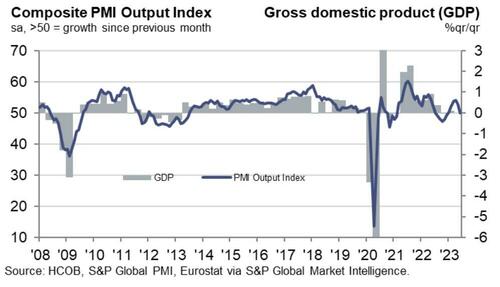
Eurozone producer prices
Source: Bloomberg
Belgium, Greece, and Ireland have seen the largest PPI deflation YoY while Hungary, Solvakia, and Latvia remain in extreme inflationary regimes...
Source: Bloomberg
The biggest driver of the decline in PPI was a 5% MoM (13.3% YoY) decline in energy prices.
However, core PPI (ex energy and constuction) remains up 3,4% YoY (despite a 0.4% MoM drop).
The picture gets more muddied as Eurozone PMIs disappointed, falling back into contraction (sub-50) as the services sector swooned in June.
Source: Bloomberg
Commenting on the PMI data, Dr. Cyrus de la Rubia, Chief Economist at Hamburg Commercial Bank, said:
“In the services sector, which after a weak final quarter of 2022 had picked up speed at the beginning of the year, all major euro countries have again lost considerable momentum. The slowdown in business activity growth was accompanied by a weaker rise in new business, lower price increases and a decline in business expectations. However, job creation in the service sector last month remained roughly as solid as in the previous month.
Overall, there is much to suggest that the slowdown in growth will continue in the coming months.
“Among the four major eurozone countries, the slump in service sector momentum was not only most pronounced in France, it is also the only country in which services companies reported a reduction in their activity compared to the previous month. In addition to general factors such as tougher financing conditions and a weaker demand situation, the pension reform protests and strikes of recent months are likely to have taken their toll here.
“Germany stands out in that companies increased their staff even more than in May. This contrasts with France, Italy and Spain, where employment growth has slowed. In all the big-4 eurozone nations, however, people are still being hired, a factor which is supporting private consumption and thus the economy or making any downturn milder.
“Price pressure in the services sector, to which the European Central Bank (ECB) is paying particular attention, has eased somewhat, but input costs are still rising strongly by historical standards and services firms are also still in a position to pass on at least some of these cost increases, some of which are due to higher wages, to end customers. This is reflected in stubbornly high core inflation, which is why the ECB is likely to continue to hike policy rates.”
So The ECB is committed to hiking 'higher for longer' into a recession?
Eurozone producer prices
Source: Bloomberg
Belgium, Greece, and Ireland have seen the largest PPI deflation YoY while Hungary, Solvakia, and Latvia remain in extreme inflationary regimes…
Source: Bloomberg
The biggest driver of the decline in PPI was a 5% MoM (13.3% YoY) decline in energy prices.
However, core PPI (ex energy and constuction) remains up 3,4% YoY (despite a 0.4% MoM drop).
The picture gets more muddied as Eurozone PMIs disappointed, falling back into contraction (sub-50) as the services sector swooned in June.
Source: Bloomberg
Commenting on the PMI data, Dr. Cyrus de la Rubia, Chief Economist at Hamburg Commercial Bank, said:
“In the services sector, which after a weak final quarter of 2022 had picked up speed at the beginning of the year, all major euro countries have again lost considerable momentum. The slowdown in business activity growth was accompanied by a weaker rise in new business, lower price increases and a decline in business expectations. However, job creation in the service sector last month remained roughly as solid as in the previous month.
Overall, there is much to suggest that the slowdown in growth will continue in the coming months.
“Among the four major eurozone countries, the slump in service sector momentum was not only most pronounced in France, it is also the only country in which services companies reported a reduction in their activity compared to the previous month. In addition to general factors such as tougher financing conditions and a weaker demand situation, the pension reform protests and strikes of recent months are likely to have taken their toll here.
“Germany stands out in that companies increased their staff even more than in May. This contrasts with France, Italy and Spain, where employment growth has slowed. In all the big-4 eurozone nations, however, people are still being hired, a factor which is supporting private consumption and thus the economy or making any downturn milder.
“Price pressure in the services sector, to which the European Central Bank (ECB) is paying particular attention, has eased somewhat, but input costs are still rising strongly by historical standards and services firms are also still in a position to pass on at least some of these cost increases, some of which are due to higher wages, to end customers. This is reflected in stubbornly high core inflation, which is why the ECB is likely to continue to hike policy rates.”
So The ECB is committed to hiking ‘higher for longer’ into a recession?
Loading…









